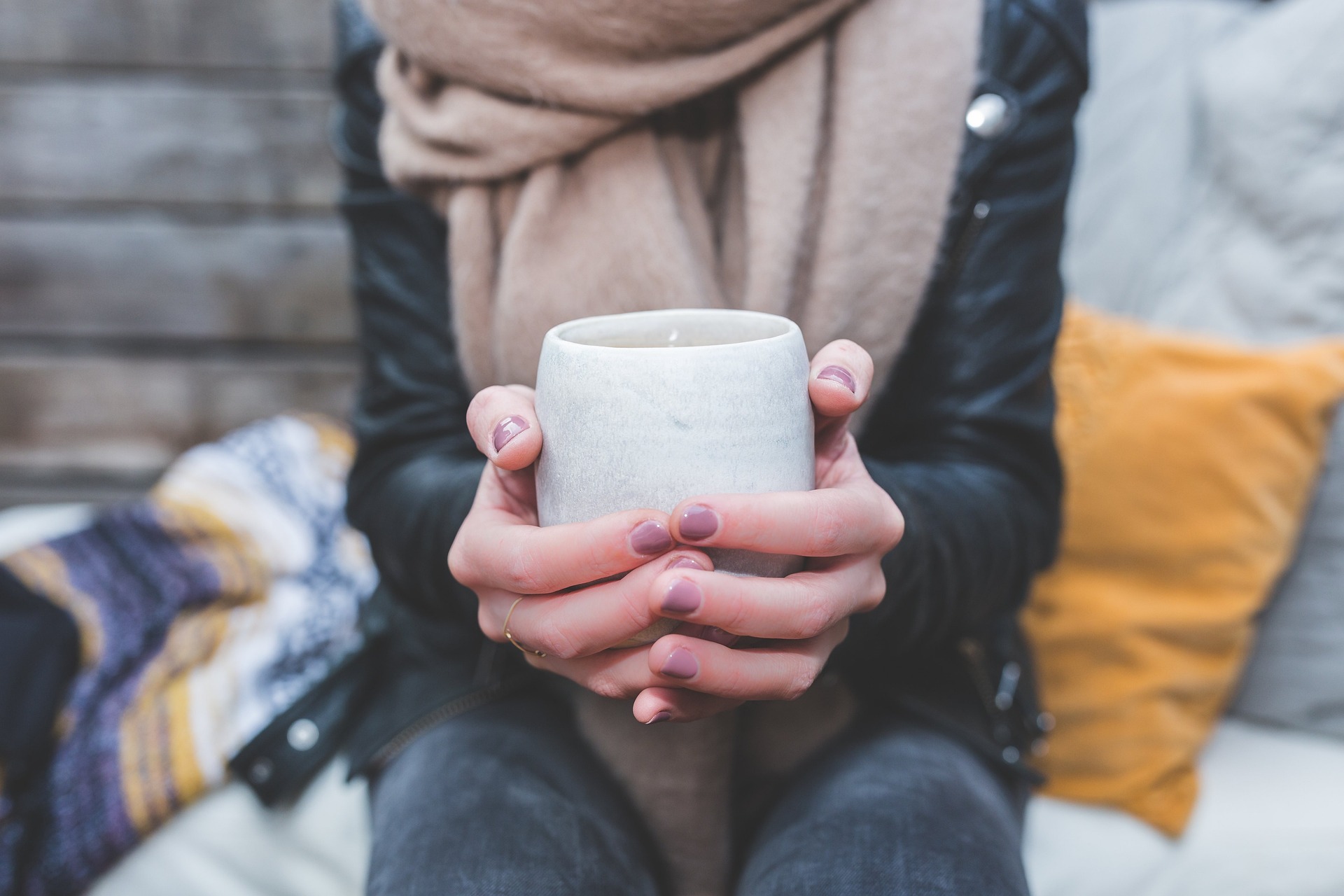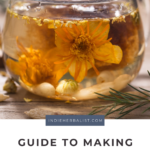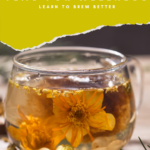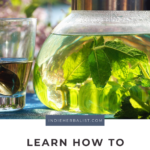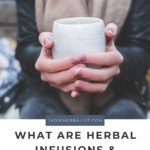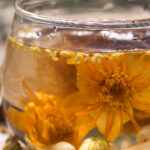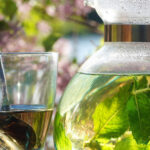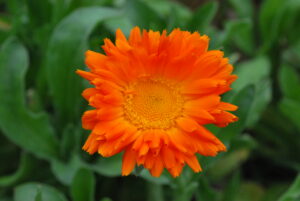Links contained in this post and elsewhere on my website may include affiliate links. When you make a purchase through these links, I earn a commission at no additional cost to you. I only link to products and services that I love - and that I think you will love, too!
Herbal tea is one of the most accessible ways to use plants to support wellness. It’s easy to make and endlessly customizable. Here’s my complete guide on herbal teas, including everything you need to start making your own! This is one of the first things I recommend new herbalists learn. Once you master the ability to make herbal tea, you can access supporting your health in an affordable, bespoke way.
Understanding the basics
Before you make your own herbal teas, you need to know a few key things. First, herbalists distinguish between two types of brews: infusions and decoctions. Infusions are used for leaves and flowers. Decoctions are better for heavier herbal materials like bark, berries, and roots. For both, start with the highest quality water available.
Overview of infusions
Most people are familiar with infusions. If you’ve ever made a cup of herbal tea with a sachet or tea bag, you’ve made an infusion. The basics you need to know about this type of preparation are:
- infusions can be made with hot or cold water
- cold water is better for herbs like marshmallow root that are very demulcent
- bring water to boil in an enamel pot, remove it from the heat, and add the herbs
- or boil water in a kettle and brew with a strainer in a mug or in a heat-safe glass container (canning jars work really well)
- generally steep them for 20 minutes minimum
- herbs with lots of vitamin and mineral goodness (like oatstraw) may be left to steep overnight for maximum nutrition
- herbal teabags from the store are also for making infusions. Usually not very strong, so I use two instead of one per serving.
Decoctions basics
Decoctions are a little more labor-intensive. Dried berries, barks, and roots need a little help releasing their goodness into water, which is where decocting comes in. It’s simply the trick of using hot water to soften dried material and unlocking the plant cells to release the good stuff.
Here’s how to make a decoction:
- made by simmering herbs in a pot
- add the dried herbs and cold water to the pot, cover, and bring to a boil
- reduce heat to simmer
- allow simmering for minimum of 30 minutes
- be sure to check frequently and add more water if needed!
- after simmering is complete, remove from the heat. May use as soon as it cools, or can place in the refrigerator overnight to continue steeping.
- final brew will usually be reduced from the original volume. Strain herbs out and add water to brew to bring back to the original volume.
If you need a quick alternative in a pinch, use powdered roots/barks/berries to make an infusion. The powder will soften up more easily and you can drink the infusion powder and all. Sort of like an herbal “instant” tea. Your digestion
My article How to Make Herbal Infusions with Thyme has even more great info on how to make infusions, and this article has more overnight steep recipes.
The best tools for making herbal tea
Buy the highest quality tools you can afford for making tea. Quality tools will last longer and won’t break as easily. If you’re on a budget, watch for sales and check thrift stores. However, I don’t recommend buying ceramic mugs or teapots at thrift stores. Older ceramics may contain lead.
When I look for tools now, I usually go with ceramic, glass, or stainless steel. Any plastic on the item (common with French presses and tea kettles) is a pass. Plastic leaches chemicals when heated and also breaks easily. The exception to the no-plastic rule is my Lifestraw pitcher. I run all of my tap water through it to remove microplastics and anything else the municipal water treatment missed. (If you’ve ever lived in areas with frequent boil water warnings, you know that you can’t always rely on your local utilities).
Benefits and drawbacks of making herbal teas
Compared to making herbal extracts with alcohol or glycerine, herbal teas have several things going in their favor. The main benefit is flexibility. Benefits of using infusions and decoctions over other preparations include:
- No need to use powdered herbs
- Can use fresh or dried herbs
- Lots of options for brewing
- Easy to customize
However, there are also a few drawbacks. These include:
- Short shelf-life after brewing
- Takes more time to brew than simply opening a bottle and measuring out the extract
- More cleanup time after brewing (wash dishes, dispose of used herbs)
- May not taste great. Add sweetener, fruit, or spices to make it taste better
Ways to boil water
It’s almost always possible to boil water for infusions, even while traveling or when the power is out. Here are a few ideas you can adapt for your situation.
- Using an electric kettle for infusions
- Stainless steel cookware or kettle on a stove to boil water for infusions
- Single electric burner and cookware or kettle
- Boiling water with a camping stove (only do this outdoors)
- Glass or enamel pot on the stove or electric burner for decoctions
- In a mug in the microwave
Options for filtering
In addition to filling your own tea bags, there are quite a few other options for filtering herbal teas. Using options like a tea thermos with a built-in strainer is perfect for keeping your brew close at hand. I’ve used all of these options at different times:
- In a glass tea thermos that comes with a built-in strainer
- With a sieve or colander lined with a coffee filter
- In a French press (my fav)
- Using disposable, single-use tea filters
- Tea ball or tea strainer designed to go in a teacup or mug
How to blend an herbal tea
Once you know how to brew, you need to know what to brew. You really can’t go wrong with a thoughtful single-herb infusion or decoction. Well-matched single-herb brews can provide a lot of comfort when done correctly. Some of my favorite single herb brews include elderflower, sage, tulsi, valerian, and elecampane.
When you get ready to begin blending your own teas, consider that more isn’t always better. Focus on one body system at a time. Don’t try to make a tea that supports the urinary tract, digestion, and the respiratory tract all at once! Instead, stay focused on one health consideration at a time.
Likewise, don’t dump 15 herbs into a jar and give it a shake. Use only three to five herbs at a time. It’s easier to see what’s working and what you need to adjust. It’s also better stewardship of the plants to use them more mindfully.
Typically, when I blend an herbal tea, I focus on one herb as the main herb. Then I add another two or three plants that complement the action of the main herb in some way. This might look like a focus on tulsi for it’s adaptogenic support of the nervous system, then adding rose, linden, and passionflower for their calming nature. Or, to harness tulsi’s traditional use for respiratory support, I might add elderflower and yarrow to riff off the traditional yarrow, peppermint, and elderflower blend for cold and flu season.
When I use packaged teas off the shelf from a grocery shop, I always brew double strength. Yep – two bags into the teacup. I also stay with trusted herbal brands that know a lot about botanicals and wellness. Their teas are higher quality and they have strict protocols for making sure the tea in your cup is what’s on the label.
Recipes to get started
Learning how to make herbal tea should be at the top of your herbalist to-do list if you are new to the craft. Even for experienced herbalists, there are plenty of ways to experiment so you can make tea under almost any condition!
Take stock of the tea-making tools you have in your kitchen and add any others you might need or want. If you’re curious about blending your own herbal teas, I have some recipes you can try! Here on Indie Herbalist, you can find:
- my green rooibos and tulsi recipe.
- Mullein and elderberry tea blend
- Beautiful blue tea made with violet flowers
The Herbal Academy has an ebook with 12 recipes, Herbal Tea Throughout the Seasons, that you can download for free! (#affiliate)
More articles about herbal teas
Using a French press is one of the easiest ways to make herbal teas.
Read my review for my favorite herbal tea recipe book, Healing Herbal Teas.
